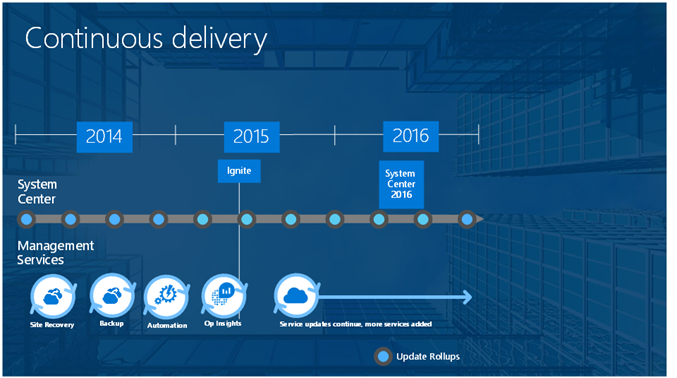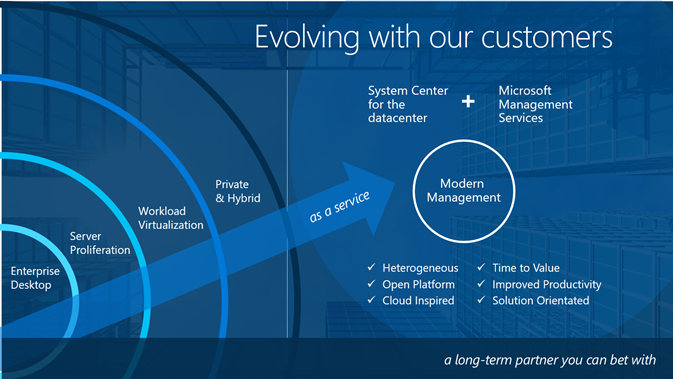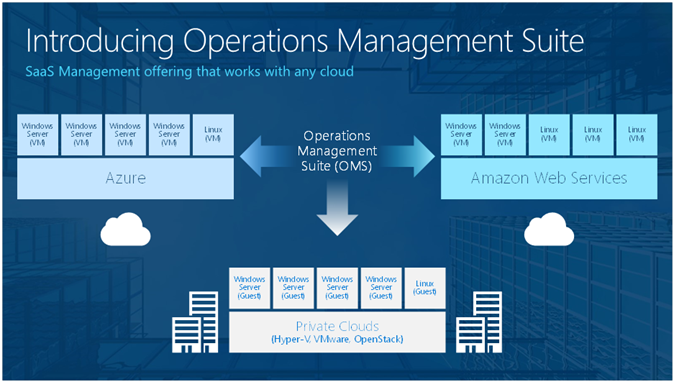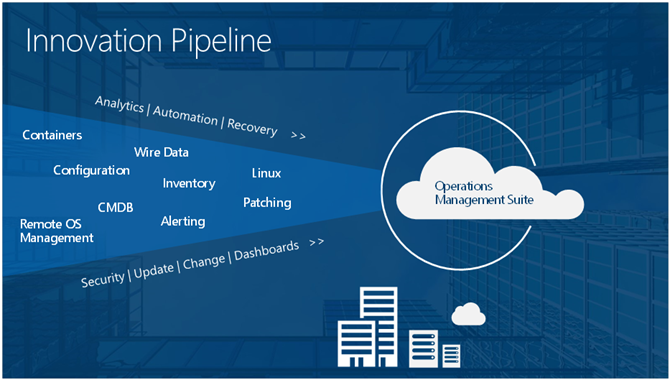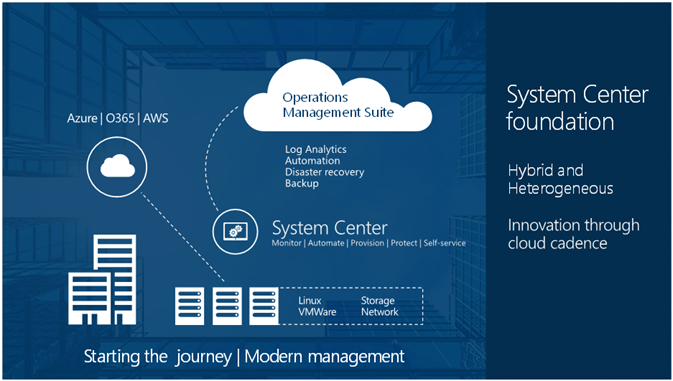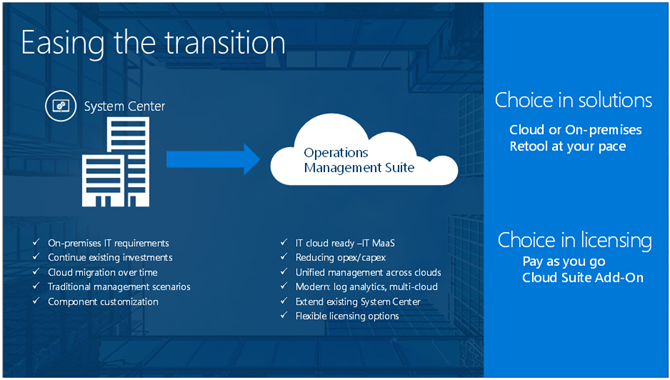UPDATE 9-4-2015:
***There is an upcoming FREE event covering the Future of System Center. This will be held on Sep 25, 2015 at the Microsoft MTC in Minnesota (http://www.microsoft.com/en-us/mtc/locations/minneapolis.aspx). This is a must attend event for any company running System Center. For more info on this event visit: http://bit.ly/1JIHS48***
Last week I was able to attend the first ever Microsoft Ignite conference in Chicago. There was a lot of exciting news announced at this conference around the many Microsoft products and technologies. Everything was covered from SharePoint, Exchange, Unified Communications, Office, Windows server, Windows 10, all things Azure and more. This post is focused for any System Center professional that was unable to attend the MS Ignite 2015 conference but what’s to know what’s up with System Center. If you had any concern about System Center going away or just want to know about the future of System Center in general this post is for you.
During conference there were many sessions related to the various System Center components however there were a couple of critical sessions that covered the future of System Center. These are the Platform Vision & Strategy sessions. These are titled:
Windows Server & System Center Futures—Bring Azure to your Datacenter (Platform Vision & Strategy)
And
Platform Vision & Strategy (6 of 7): What’s New in System Center for Management
These sessions are important because they featured System Centers top guy Jeremy Winter and he talked about future direction of the management solutions. In this post I will sum up key information from each of these sessions.
NOTE: This post is my perspective on the Platform Vision & Strategy sessions from Ignite and do not represent the opinions of Microsoft.
Traditionally System Center has been a complete management stack for IT Operations. This is not going to change but will continue to get better. The stack consists of: Managing endpoints (PC’s/Mobile device/servers) – *SCCM/Intune* | Monitor – *SCOM* | Automation – *Orchestrator (SMA)* | Provision – *VMM* | Service Management – *SCSM* | Protection – *Data Protection Manager* | Self-service – *Azure Pack* also represented in the following screenshot from one of the session slides.
So we are now in the year 2015 and have not had a new major version of the entire stack since 2012. However since the release of System Center 2012 we have seen a steady progression of enhancement to the stack. We have seen it move from SP1 to R2 and now updates and new features through update rollups.
These update rollups have been released on a faster cadence at a speed we have not seen from Microsoft before. In fact we have recently seen a round of new features in update rollup 6 and more announced at Ignite. Below is a list of key features that stuck out to me along with slides from one of the Platform Vision & Strategy sessions giving insight into where the System Center components are headed next.
SCCM: Support for Windows 10 and a plethora new MDM features.
Automation: Graphical authoring. How cool is this!, DSC Push/Pull servers now in SMA and you can manage DSC in SMA, Role Based Access Control.
DPM: Backup as a Service in Azure Pack powered by DPM, VMWare Backup, Azure Backup offline seeding.
SCOM: LAMP Stack monitoring, Scheduled Maintenance Mode.
VMM: Ability to manage Azure IaaS VM’s in VMM. 🙂
SCSM: Workflow server scale-out, Azure Stack IT Marketplace
All of those enhancements are exciting for System Center as it appears to be leading up to a major release soon. As you can see from the following slide from one of the sessions we can be on the lookout for an all new version of System Center in 2016. Whew……development of System Center is not slowing down…..and yes Microsoft is committed to future development of on-prem System Center technologies many of use today.
Now with that being said take a close look at the following screenshot and notice cloud technologies that have been introduced into this story. We will discuss this more later in the post.
The world of business has been transforming with the explosion of mobile devices, cloud technology and the workforce becoming more tech savvy. In this new world IT is forced to keep up and move at a faster pace than ever before. This is touching all facets of IT included the management layer. Microsoft knows this and is ahead of the curve being committed to help us IT pro’s stay at the forefront of this shift. You can see this happening across all of Microsoft’s technologies and System Center is no exception.
We are seeing a shift of Traditional IT management to Modern IT management. The System Center stack also needs to make this shift enabling us to effectively manage IT operations regardless if they are Microsoft, Linux, Unix, Mac, on-prem, or in the cloud. Microsoft is making that shift with the stack and helping us to stay ahead of the curve. The following screenshot represents how Microsoft is making that transition for and with us. We can be confident to invest in System Center at an organizational level and a personal career level knowing Microsoft will continue to evolve the toolset.
The Microsoft Operations Management Suite (OMS) was announced at Ignite 2015. OMS helps us progress even further towards Modern Management. OMS is essentially IT Operations Management from the cloud as a SaaS offering. OMS consists of:
- Operational Insights
- Azure Backup
- Azure Site Recovery
- Azure Automation
The OMS components span on-prem and cloud so regardless of where your infrastructure is you will be able to manage it.
For example Operational Insights collects and stores data from your on-prem servers and gives you an easy interface for organizing and visualizing all of the data collected. Azure Backup can protect on-prem servers and back that data up to Azure it also has the ability to integrate with DPM. Azure Site Recovery is disaster recovery protection for virtual machines and has some integration with VMM. And Azure Automation is PowerShell workflow that can be used to automate on-prem or Azure IaaS.
OMS is true unified IT operations management across on-prem datacenters and public clouds because it touches on-prem or cloud and integrates with the System Center stack. For an overview of OMS visit:
https://www.microsoft.com/en-us/server-cloud/operations-management-suite/overview.aspx
The following slide is from one of the Platform Vision & Strategy Ignite sessions and gives you an idea of where OMS is headed. The future direction of OMS is to give us the ability to manage any cloud offering regardless if this is Azure, AWS, VMWare’s private cloud, OpenStack’s private cloud and of course Microsoft’s private cloud.
The following two slides display the journey and different management workloads that will flow into OMS. Take note as this gives a lot of insight into the direction of OMS, System Center, and where you should start to focus your time to stay competitive from a skills standpoint.
This next slide represents Microsoft’s commitment to continue development for System Center. At the same time Microsoft will also continue to develop OMS and give us a way to transition to OMS at our own pace and at the pace of our customers.
The writing is on the wall more and more management of IT is moving to the cloud and who knows maybe someday it will all be out there. For now continue to invest time into System Center but also transition to OMS in areas that make sense for you to do so.
For the full channel 9 videos on the two Platform Vision & Strategy sessions I referenced throughout this post visit:
Windows Server & System Center Futures—Bring Azure to your Datacenter (Platform Vision & Strategy)
https://channel9.msdn.com/Events/Ignite/2015/FND1451
Platform Vision & Strategy (6 of 7): What’s New in System Center for Management

![clip_image001[4] clip_image001[4]](https://www.buchatech.com/wp-content/uploads/2015/05/clip_image0014_thumb1.png)
![clip_image002[4] clip_image002[4]](https://www.buchatech.com/wp-content/uploads/2015/05/clip_image0024_thumb1.png)
![clip_image003[4] clip_image003[4]](https://www.buchatech.com/wp-content/uploads/2015/05/clip_image0034_thumb1.png)
![clip_image004[4] clip_image004[4]](https://www.buchatech.com/wp-content/uploads/2015/05/clip_image0044_thumb1.png)
![clip_image005[4] clip_image005[4]](https://www.buchatech.com/wp-content/uploads/2015/05/clip_image0054_thumb1.png)
![clip_image006[4] clip_image006[4]](https://www.buchatech.com/wp-content/uploads/2015/05/clip_image0064_thumb1.png)
![clip_image007[4] clip_image007[4]](https://www.buchatech.com/wp-content/uploads/2015/05/clip_image0074_thumb1.png)
